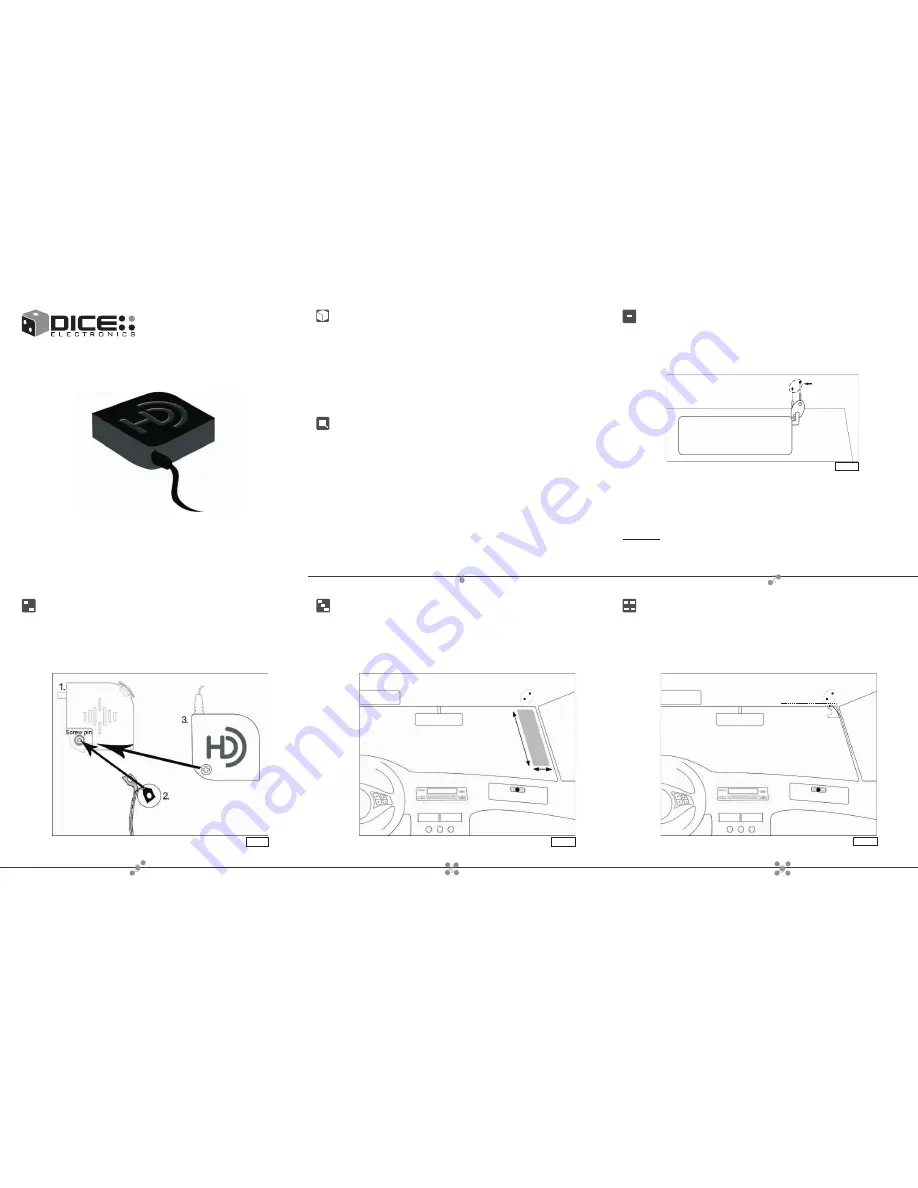
HD Radio Antenna
1
2
4
5
3
Installation Instructions
Safety notices.
$
$
$
$
Read the entire installation instructions prior to installation of the product. If you don't feel
comfortable with the installation contact a qualified Car Stereo/12 Volt specialist for the
installation.
To ensure no interference is caused, antenna cables must be laid at a sufficient distance
from existing cable harnesses.
Use cable grommets (not included) to protect cables
against sharp edged holes.
You must observe the vehicle manufacture's safety notices (airbags, alarm systems, trip
computers, immobilizers) during installation.
This module is designed for inside application only and may stop working if exposed to
water.
Before starting the installation check:
?
?
?
Space available (see illustration no. 3)
Routing of antenna cable (see illustration no. 8 and 9 )
Availability of a Vehicle Body Ground (see sketch no. 1)
-1 x Antenna module (with pre-mounted screw)
-1 x Mounting base
-1 x Mounting base installation template (part of box)
-1 x Reception element
-1 x 2.5 mm Ground Screw
-1 x Star Washer
-1 x Alcohol wipe
-Household adhesive tape
-Philips screw driver with tip size P1
-Tape measure
For complete content of the product package:
Other needed materials and tools:
STEP 3:
If needed, u
from the
inside of the windshield Then use the alcohol wipe included in the package to clean the
installation area for the antenna and reception element (see figure no. 3) approx. 4 inches /
100 mm from the A-pillar starting from the top of the front window down approx. 24 inches /
600 mm to the dash board).
se a commercial window cleaner to remove dirt and grease
.
Positioning the mounting template
STEP 4:
.
Position mounting base installation template on the passenger side corner
of the front window
Push the template up until it touches the roof underneath the
headliner and then push it right until it touches the metal A-pillar frame.
To keep the template in place you may use clear scotch tape. This template is
designed to aid in optional placement of the antenna. Placement of the antenna
closer to the A-pillar or the roof will degrade reception.
(see figure
no.4)
Getting started - Locating a suitable ground point.
STEP 1
STEP 1.1
: Remove the passenger side sun visor.
: An ideal ground point is located under the screw. Scratch the paint around
the sun visor-mounting hole with a sharp object to ensure that the ground strap can
get a good electrical contact to the vehicle body metal.
Requirements for Proper Adhesion.
?
?
During installation, the inner side of the front window as well as all elements to be
adhered to the front window must have a minimum temperature of 64 Fahrenheit (18
Celsius) in a low humidity environment. We recommend the installation in a heated
garage or similar if the ambient temperature is too low and or the humidity is too high.
Ensure that the front window is absolutely dry on the inside where the antenna will
be installed!
Important!
Do not touch the adhesive surfaces of the reception element carrier film and/or
the mounting base after peeling off the protective foil, to avoid degradation
of adhesion!
Sun visor
Figure 1
Do not extend he ground lead if at all possible!
Vehicle's body
ground
A-pillar
roof line
A-pillar frame
glass line
A-pillar
24"/600mm
4"/100mm
Cleaning of installation area.
Do not remove adhesive pad!
Strip back the protective film.
Hook the metal ring to the
screw pin on the mounting base.
Assembling of reception element and antenna
STEP 2:
Take the mounting base and hook the ring found on the end of the reception
element to the screw pin located on the mounting base, adhesive side down. Place the
antenna module on the lower pin of the mounting base, then snap the module on to the
base. Fasten the module to the base by tightening the pre-mounted screw. Do not use a
powered screwdriver to avoid stripping the thread!
Vertical installation of the HD Radio Antenna
Figure 3
Figure 4
Figure 2
Figure 2
NOTE:
Horizontal installation of the antenna is also possible. (See figure 8 and 9.)




















